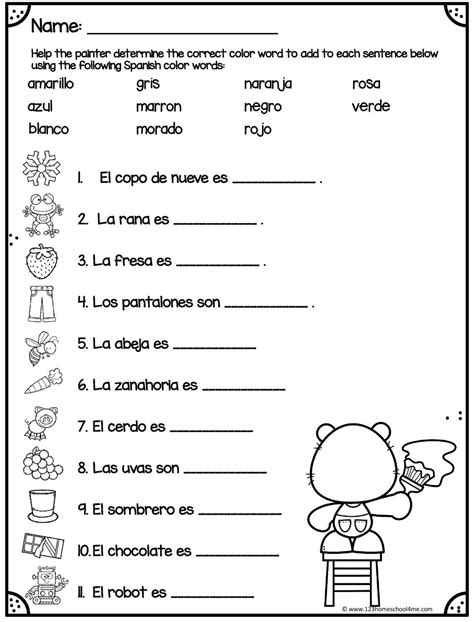Embark on a Spanish-Speaking Adventure
Learning Spanish as a fourth grader can open up a world of opportunities and benefits. Not only can it enhance cognitive abilities, but it can also expand cultural horizons and foster global connections. This comprehensive guide will provide everything you need to know about Spanish for fourth graders, including curriculum alignment, effective teaching strategies, engaging activities, and essential resources.

Curriculum Alignment
The curriculum for Spanish for fourth graders is designed to build upon the foundational knowledge acquired in the primary grades. According to the National Foreign Language Center, the curriculum focuses on the following key areas:
- Communication: Students develop basic conversational skills and can engage in simple dialogues.
- Vocabulary and Grammar: They expand their vocabulary and understand basic grammar concepts, such as noun-adjective agreement and verb conjugations.
- Culture: They learn about the customs, traditions, and perspectives of Spanish-speaking cultures.
Effective Teaching Strategies
Engaging and effective teaching strategies are crucial for fostering Spanish proficiency in fourth graders. Here are some proven approaches:
- Immersive Learning: Create a Spanish-rich classroom environment where students are exposed to the language through songs, games, videos, and interactive activities.
- Project-Based Learning: Design projects that allow students to apply their Spanish skills in real-world scenarios, such as creating Spanish-language presentations or interviewing native speakers.
- Differentiated Instruction: Adapt instruction to meet the individual needs of students. Provide extra support for struggling learners and challenge advanced students with extension activities.
Engaging Activities
Captivating activities make learning Spanish more enjoyable and memorable. Consider incorporating these activities into your lesson plans:
- Spanish Story Time: Read aloud Spanish books and have students participate in role-playing and discussions.
- Spanish Bingo: Engage students in a fun game while practicing vocabulary and listening skills.
- Spanish Cooking Class: Introduce students to Spanish culture and language through hands-on cooking experiences.
Essential Resources
Numerous resources can support Spanish for fourth graders. Here are some valuable options:
- Textbooks: Choose age-appropriate textbooks that provide engaging content and structured lessons.
- Online Programs: Utilize online platforms that offer interactive exercises, games, and videos.
- Spanish Immersion Programs: Consider enrolling students in after-school or weekend immersion programs to enhance their proficiency.
Tips and Tricks
- Make it Fun: Integrate games, songs, and interactive activities to make learning Spanish enjoyable.
- Encourage Repetition: Repeat vocabulary and grammar concepts frequently to improve retention.
- Foster a Growth Mindset: Encourage students to view mistakes as opportunities for learning.
- Use Visual Aids: Visuals, such as flashcards and charts, help students retain information.
- Provide Positive Reinforcement: Acknowledge and reward students for their effort and progress.
Common Mistakes to Avoid
To ensure effective Spanish instruction, avoid these common pitfalls:
- Overwhelming Students: Introduce new vocabulary and grammar concepts gradually.
- Ignoring Pronunciation: Teach proper pronunciation from the beginning to avoid fossilized errors.
- Translating Word-for-Word: Help students understand the meaning of words and phrases in Spanish, rather than relying on direct translation.
- Ignoring Cultural Context: Integrate cultural information to provide a deeper understanding of the language.
- Assuming Too Much Prior Knowledge: Review foundational concepts before moving on to more advanced material.
Frequently Asked Questions
1. When should students start learning Spanish?
Starting Spanish in fourth grade is an ideal time, as students have developed sufficient cognitive abilities and can build upon their foundational skills.
2. How much Spanish should fourth graders learn?
Fourth graders typically learn basic conversational skills, foundational grammar concepts, and a vocabulary of approximately 500 words.
3. What are the benefits of learning Spanish for fourth graders?
Spanish proficiency enhances cognitive abilities, expands cultural horizons, and fosters global connections.
4. How can parents support their fourth grader’s Spanish learning?
Encourage them at home, provide opportunities for immersion, and ensure they have access to resources.
5. What resources are available for fourth graders learning Spanish?
Textbooks, online programs, immersion programs, and flashcards are valuable resources for students and teachers.
6. What are the most common mistakes to avoid when teaching Spanish to fourth graders?
Overwhelming students, ignoring pronunciation, translating word-for-word, ignoring cultural context, and assuming too much prior knowledge.
7. How can I make Spanish learning fun for fourth graders?
Incorporate games, songs, videos, and hands-on activities to engage students and make learning enjoyable.
8. How can I assess my fourth graders’ Spanish proficiency?
Use a variety of assessment methods, such as oral presentations, written assignments, and interactive quizzes.
Conclusion
Spanish for fourth graders provides a solid foundation for future language development and intercultural understanding. By embracing effective teaching strategies, engaging activities, and essential resources, teachers can empower students to succeed in their Spanish-learning journey. With support, encouragement, and consistent practice, fourth graders can achieve proficiency in Spanish and reap the numerous benefits it offers.
